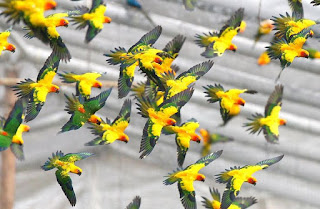sun parakeet or sun conure is a medium-sized brightly colored parrot native to northeastern South America. The adult male and female are similar in appearance, with predominantly golden-yellow plumage and orange-flushed underparts and face. Sun conures are very social birds, typically living in flocks. They form monogamous pairs for reproduction and nest in palm cavities in the tropics. Sun conures mainly feeds on fruits, flowers, berries, blossoms, seeds, nuts and insects. Conures are commonly bred and kept in aviculture and may live up to 30 years. This species is currently threatened by loss of habitat and trapping for plumage or the pet trade. Sun conures are now listed as endangered by the IUCN
Description characteristic
 On average, sun parakeets weigh approximately 110 g (4 oz) and are around 30 cm (12 in) long.They are sexually monomorphic.
Adults have a rich yellow crown, nape, mantle, lesser wing-coverts,
tips of the greater wing-coverts, chest, and underwing-coverts. The face
and belly are orange with red around the ears. The base of the greater
wing-coverts, tertials, and base of the primaries are green, while the
secondaries, tips of the primaries, and most of the primary coverts are
dark blue. The tail is olive-green with a blue tip. From below, all the flight feathers
are dark greyish. The bill is black. The legs and the bare eye-ring are
grey, but the latter often fades to white in captivity (so using amount
of grey or white in the eye-ring for determining "purity" of an
individual can be misleading). It is easily confused with the closely
related jandaya parakeet and sulphur-breasted parakeet,
but the former has entirely green wing-coverts, mantle and vent, while
the latter has green mottling to the mantle and less orange to the
underparts. The sun parakeet is also superficially similar to the
pale-billed golden parakeet. Juvenile sun parakeets display a predominantly green plumage
and resemble similar-aged sulphur-breasted parakeets. The distinctive
yellow, orange, and reddish colouration on the back, abdomen, and head
is attained with maturity.
On average, sun parakeets weigh approximately 110 g (4 oz) and are around 30 cm (12 in) long.They are sexually monomorphic.
Adults have a rich yellow crown, nape, mantle, lesser wing-coverts,
tips of the greater wing-coverts, chest, and underwing-coverts. The face
and belly are orange with red around the ears. The base of the greater
wing-coverts, tertials, and base of the primaries are green, while the
secondaries, tips of the primaries, and most of the primary coverts are
dark blue. The tail is olive-green with a blue tip. From below, all the flight feathers
are dark greyish. The bill is black. The legs and the bare eye-ring are
grey, but the latter often fades to white in captivity (so using amount
of grey or white in the eye-ring for determining "purity" of an
individual can be misleading). It is easily confused with the closely
related jandaya parakeet and sulphur-breasted parakeet,
but the former has entirely green wing-coverts, mantle and vent, while
the latter has green mottling to the mantle and less orange to the
underparts. The sun parakeet is also superficially similar to the
pale-billed golden parakeet. Juvenile sun parakeets display a predominantly green plumage
and resemble similar-aged sulphur-breasted parakeets. The distinctive
yellow, orange, and reddish colouration on the back, abdomen, and head
is attained with maturity.breeding and rearing of birds.
The sun conure is noted for its very loud squawks and screams compared to its relatively small size. It is capable of mimicking humans, but not as well as some larger parrots. Sun conures are popular as pets because of their bright coloration and curious nature. Due to their inquisitive temperaments, they demand a great deal of attention from their owners, with whom they can be loving and cuddly. Hand reared pets can be very friendly towards people that they are familiar with, but they may be aggressive with strangers and even territorial with visitors. Sun conures are capable of learning a great deal of tricks and can even perform in front of a live audience. They enjoy listening to music, to which they occasionally sing and dance to. L
 ike many parrots, they are
determined chewers and require toys and treats to chew on. Many owners
clips their conure's wings but this is not necessary if the proper
precautions are put in place. Due to environmental hazards, conures
should not be allowed to fly unsupervised. Sun conures are great
candidates for outdoor flight when well trained as they are loyal but
risk potential must be minimized. In captivity, their lifespan ranges
from 15 to 30 years.
ike many parrots, they are
determined chewers and require toys and treats to chew on. Many owners
clips their conure's wings but this is not necessary if the proper
precautions are put in place. Due to environmental hazards, conures
should not be allowed to fly unsupervised. Sun conures are great
candidates for outdoor flight when well trained as they are loyal but
risk potential must be minimized. In captivity, their lifespan ranges
from 15 to 30 years.


No comments:
Post a Comment